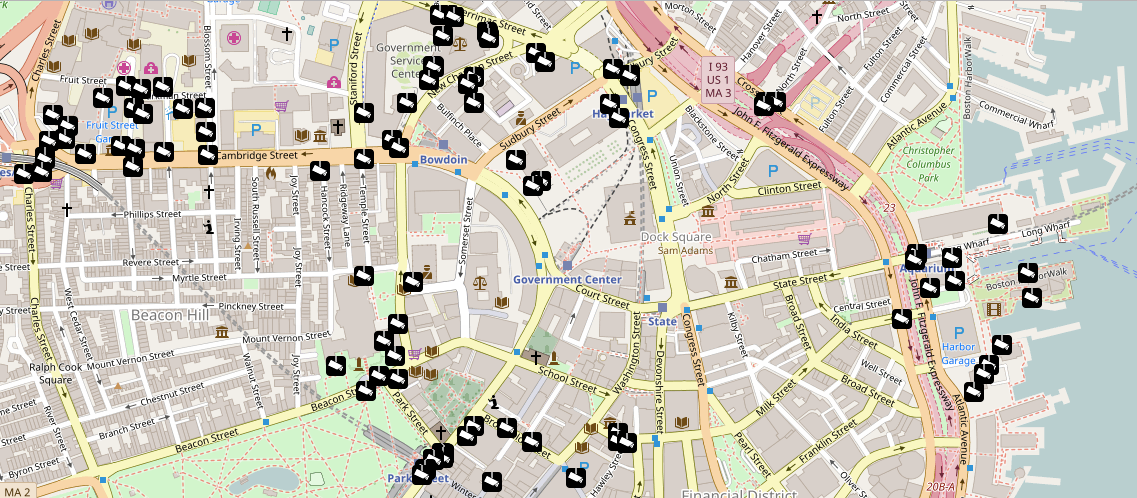 We have mapped surveillance cameras in many cities and towns, but downtown Boston remains little explored. To fix that, our surveillance camera mapping picnic will be Saturday, August 19th. We will meet near the Visitor Center on Boston Common (139 Tremont St) starting at noon.
We have mapped surveillance cameras in many cities and towns, but downtown Boston remains little explored. To fix that, our surveillance camera mapping picnic will be Saturday, August 19th. We will meet near the Visitor Center on Boston Common (139 Tremont St) starting at noon.
The schedule is:
- noon-1pm: food and training;
- 1pm-2:30pm: map cameras;
- 2:30pm-3:30pm: come back and debrief.
We would appreciate it if you told us you will be there.
We will show you how to map cameras using Open Street Map (OSM) software on your smart phone or on a paper map for later entry into OSM. We have tested some mobile phone OSM software and will provide How To guides. If you want to help with testing the apps or writing the How To guides, please contact us.
We setup a PiratePad to share what people are bringing for food, drinks and other items. If you can bring things or help out, please update it with what you can do.
We plan to have these events in other cities before the Winter comes, so contact us if you want to set one up in your community. To find out where people have mapped cameras so far, check out cctv.masspirates.org.
Looking forward to seeing you on the 19th!


They caught this guy immediately because they had him dead to rights on video. Had he known where the camera was he could have avoided detection by donning a balaclava or attacking her somewhere else. Well done creating a one stop shopping list of places for sexaul assaulters to avoid when targeting women. I will be taking a screenshot of this post in just in case you decide to censor me, as the PP has chosen to do in the past, when I attempt to discuss women’s rights. http://www.unionleader.com/crime/video-captures-woman-beaten-outside-planet-fitness-in-rochester-20170620
This is typical of arguments made by those who support mass surveillance. We need surveillance to keep us safe from terrorists, murderers, pedophiles, and rapists. (Or if you’re Arlo Guthrie, perhaps that would be “mother rapers, father stabbers, father rapers; all those father rapers, sitting right here on the bench …”).
Now, that’s not to say there aren’t examples where surveillance cameras have provided useful evidence — there have been. An existential proof is trivial to do, but you cannot draw general conclusions from a small number of incidents. The UK made this mistake — CCTV played a significant role in the arrest of the Brixton Nail Bomber in 1999, which led the UK home office to take the position “the more CCTV the better”, a position that hasn’t survived critical scrutiny over time. (See UK Home office research study 292. 2005. Martin Gill and Angela Spriggs, Chapter 4).
Or take San Francisco’s Community Safety Camera program, which was studied by researchers at UC Berkeley’s Center for Information Technology research in the Interest of Society (CITRIS). From 2005–2008, there were only six cases where CCTV footage led to criminal charges (all six cases involved the SFO police department’s gang unit); researchers found reduced witness cooperation in areas where CCTV cameras were present; and, while researchers observed a deterrent effect for property crime (like purse snatching), they found no deterrent effect for violent crime (assault, battery, rape, etc).
So there real question here: could the resources spent on camera deployments be more effectively used? Before we can answer that question, we have to have an awareness of the extent of current CCTV deployments. That’s our goal for the 19th — to enhance the public awareness of CCTV deployments in downtown Boston.
There are plenty of unsolved crimes, despite CCTV footage. The previous commenter’s article cites on of those cases (the last paragraph reads “Police are asking anyone with information that could help in the investigation to call … Cash rewards are offered for information leading to an arrest”, which implies that there has not been an arrest).